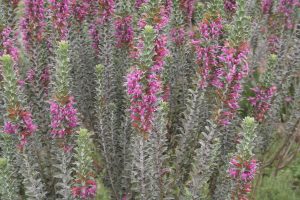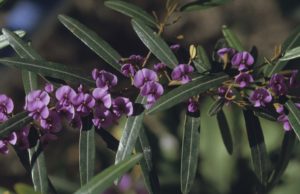Acacia Study Group Newsletter No. 151, January 2022
SG member Sandra McKenzie and her husband Don have taken an interest in the rare and endangered Acacia cretacea (Chalky Wattle), found only in a very limited area on Eyre Peninsula SA. Sandra and Don have visited the site regularly over the last 6 years, to monitor the health of the population, but on their most recent visit found that about 80% of the population had died. The site is being overtaken by what appears to be Eucalyptus incrassata. Sandra has raised her concerns with representatives of the State Herbarium, requesting they visit the site to make an assessment.
A new series of Australian wattle stamps was issued late last year, under the title ‘Wattle Wonders’. There are three stamps, featuring Acacia leprosa ‘Scarlet Blaze’, A. purpureopetala and A. alata var. biglandulosa.
Eremophila Study Group Newsletter No. 133, December 2021

The feature species is Eremophila laanii, a shrub to small tree that is found on riverbeds and flats along the Murchison and Gascoyne Rivers in WA. SG members have found this species to be sturdy and easy maintenance, with fabulous flowering and bird-attracting features. It is happy in a range of soils, but does best in full sun, and in areas without a lot of competition from other plants. They are drought tolerant and pretty frost hardy, and can be easily propagated from cuttings or suckers.
The long-awaited book “Growing Eremophila”, by Russell Wait is now available. Much more than a gardening book, it is an invaluable compendium that is clearly presented and comprehensive in its scope. The SG has also recently released an update of the superb book “A field guide to the Eremophilas of Western Australia”, with order forms on the SG’s website.
Garden Design Study Group Newsletter No. 118, February 2022
The theme for this newsletter is ‘Gardens in shade’. Some considerations when designing for shade include:
Be aware that latitude will have a large bearing on your design; as the sun moves seasonally, the angle of sunshine rays become progressively lower, automatically providing increasing areas of shade from trees and other structures.
When planting large trees, decide when and where you want the shadow to be cast, then locate the tree in the correct position. As a garden matures and plants grow, you will invariably have greater areas and density of shade, which you may need to adjust or account for.
Listen to the plants – a good rule to follow is that the size of the foliage generally indicates the amount of shade a plant will tolerate. So very shady gardens will have large leaves which offer appropriate surface area to collect and process the minimal sunshine penetrating through the leaf canopy above.
Courtyards can be difficult because the walls often create deep shade, except for a hot burst of sun in the middle of a summer day. to deal with this, it is important to choose plants that have the tolerance to deal with these conditions. The best solution may in fact be to create shade structures for the midday sun. courtyards also lend themselves to container gardening, and the vertical plane can be an important extension to the garden with containers built into walls at different heights.
Australian Pea Flower Study Group Newsletter No. 3, December 2021

Observing leaf structure is an important element of plant identification. Stipules, small appendages at the base of the leaf stalk, are important characters in pea flower identification. Many plants in the pea family have stipules, and their presence and characteristics can be useful in identifying the genus or species. For example, the presence of stipules is a distinguishing feature in the genus Pultenaea. Pultenaea stipules are dry and membranous, and are fused for most or part of their length behind the leaf stalk.
The featured genus this newsletter is Hovea, a genus of sub-shrubs, shrubs or small trees with mostly purple, blue or mauve flowers. Endemic to Australia, they occur in all states and mainland territories. There are currently 38 accepted species, with several noted to do well in cultivation. Member Hans Griesser (SA) shares that the most spectacular pea flower plant he has grown is undoubtedly Hovea pungens, which has amazing deep blue flowers. Ross McDonald (Vic) has been experimenting with germination of Hovea seeds. His technique involves several pre-treatments: putting seeds in a small jar with boiling water and allowing it to cool; then adding an eye dropper of concentrated smoke water and leaving for 24 hours; draining and leaving just moist in a petri dish; then using Mancozeb to control fungal attack. Seeds that are not swollen are treated with boiling water and smoke water again, sometimes 2 or 3 times. Swollen seeds are then potted into a 4:1 mix of commercial native potting mix and perlite. Ross will report on developments as the season progresses.
